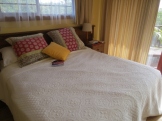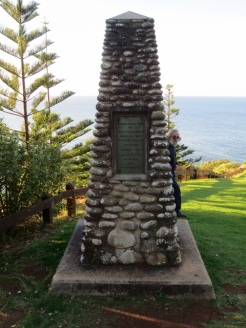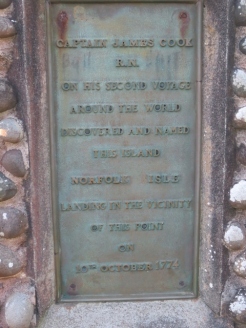Update 30/4/19: Eagle-eyed readers may notice that this post looks a little different. That’s because I accidentally deleted it when I was trialling posting using an iPad. I was able to recover it using the internet archive at Wayback Machine, but I had to tweak things a little to restore it fully. And alas, I could not restore the comments at all.
***
Last week we made a quick trip to Dunkeld for a Chef’s Package at the Royal Mail Hotel.
It’s a longish but easy drive (about four hours from Melbourne) but true to form we left our departure a bit late, so our only stops en route were for a quick sandwich at a roadhouse (where a quizzical eyebrow was raised when I asked them to remove the cheese because they didn’t have anything without lashings of fatty dairy) – and a very sudden halt for this when we were almost at our destination:
I have no idea what it was – perhaps a silo being transported somewhere? – but we were quite startled when a small truck drove over onto our side of the road waving a hand-held stop sign. Well, we did stop, of course, and it turned out that this oversize thing was right where we were planning to go and it was using up both sides of the road. Discretion is the better part of valour as they say, so we made a brief diversion and my new Mazda had its first venture onto a dirt road… and we returned to civilisation just in time to be held up by the tail end of proceedings.

Royal Mail Hotel Dunkeld (Wikipedia Commons*)
Five minutes later we checked into the Royal Mail Hotel. And that’s when I realised that I’d forgotten my camera which takes much better photos than my phone does. But it didn’t matter much for the cellar tour because alas, it wasn’t really very interesting. A tour guide needs to have a good spiel to make racks of wine bottles interesting but it ought not to sound like it’s been learned off by heart and be full of management-marketing jargon. And the wines on tasting were not in the same class as the wines we have courtesy of the Finest Drop wine club through Hampton Gate Cellars. Maybe we’ve been spoilt by Steve’s tastings and wine club dinners (though they’re not very expensive), but the Royal Mail’s Chef’s Package is marketed as a gourmet destination so a little less talk about their multi-thousand dollar wines and a bit more attention to their tasting wine choices would be a good idea. (They should also provide a spittoon to pour away unwanted wine since it’s part of responsible wine service). However, (apart from the bookshop being open only on weekends, which is fair enough) that was the only disappointment of our stay.
We had a restorative tea and coffee and some scrumptious cakes at Cafe 109 on Parker Street, which – we learned from the plaque outside – used to be the State Savings Bank. (There are small historic plaques which feature in their ‘historic walk’ all over town, which is a good initiative, evidence of the way this town has gone out of its way to reinvent itself as a desirable tourist destination). Cafe 109 is a nice eatery with very good and friendly service and it looks like a place that would be good for an inexpensive dinner too.
We then took a stroll down the main street in perfect Spring weather. The town boasts an information centre, with an impressive range of resources and some very helpful staff who were assisting other tourists who planned to go further afield. There is also an impressively upgraded Anzac memorial in the park (courtesy of Centenary funding), a museum, and an arboretum which made me wish we could stay a little longer but we couldn’t manage it this time.
- A bookish moment!
- Anzac memorial
- Cafe 109
There were also some shops, including a general store that has changed dramatically since our last visit to Dunkeld…
On that occasion we’d ‘come into town’ from Bona Vista, a turn of the century farmhouse in the Victoria Valley, a wonderful place to stay. It had no phone, no TV, and none of the upmarket ‘necessities’ you find in so-called farmstays today – but it was very comfortable, blissfully quiet, and perfect for relaxing with a book of course. We had a week there, celebrating the end of the millenium with champagne provided by our hosts. Our silly Silky Terrier had an adventure with some inquisitive bees but was rescued by Tim (who unlike me isn’t allergic to bees); we were visited by kangaroos and wombats, and when I wasn’t reading I sketched from the verandah while Tim cooked up a storm in the kitchen. It was 20 minutes by road from Dunkeld so we drove in to do our shopping – and the only flaw was that the store didn’t stick such exotics as capsicum or garlic!
 Well, how things have changed in 18 years! The Dunkeld General Store has certainly gone upmarket since then although it still has some shelves of everyday groceries too. Most locals probably do their serious shopping in nearby Hamilton, so it’s mainly the kind of things that people run out of, and the main emphasis is on gourmet treats and platter foods. Of course we bought some to bring home, and we would have bought lots more to supplement our holiday pantry if we’d been staying in the area for a while.
Well, how things have changed in 18 years! The Dunkeld General Store has certainly gone upmarket since then although it still has some shelves of everyday groceries too. Most locals probably do their serious shopping in nearby Hamilton, so it’s mainly the kind of things that people run out of, and the main emphasis is on gourmet treats and platter foods. Of course we bought some to bring home, and we would have bought lots more to supplement our holiday pantry if we’d been staying in the area for a while.
However, the main purpose of our jaunt was dinner at the Royal Mail. We had dined there too in 2000, not knowing anything about its growing credentials and *chuckle* were agreeably surprised by the menu at what we thought was just a country pub. Was it the next year it was awarded a coveted chef’s hat in the Good Food Guide? I can’t remember…
Anyway, at the hotel’s new purpose-built restaurant called Wickens after its British-born chef, we opted for the five course degustation with matched wines from the cellar. It was not an easy choice because everything looked highly desirable but in the end the truffle in the first course trumped the turnip crème fraîche, and the wattle smoked duck trumped the pork loin with hispi cabbage. Here’s the slide show, minus the amusé, the flathead with young broad bean leaves and kohlrabi, and the medlar tart, either because they’re on Tim’s phone or we were too busy eating to remember to take a photo:
The cellar match wines were not only the least expensive but also a more adventurous choice than the Australian or French matching options. The wine of the night was the South African syrah, but it was also interesting to try our first ever Armenian wine. Armenia is said to be the site of the world’s oldest winery at cave in Vayots Dzor but Georgia also makes the claim to have invented wine in 6000BC. Whatever the truth of it, Armenia makes an interesting wine and we enjoyed drinking it. We also liked the American pinot noir, from a region we haven’t encountered before. There was also a 2012 Robert Weil Riesling, but like most German dry whites, it was a bit sweet for our taste.
 The next morning, looking out at Mt Sturgeon, we had breakfast in the main hotel restaurant, served by one of waitstaff from the night before. We had been very impressed by the service in the Wickens restaurant because we know from dining in country restaurants that it’s not easy to train and keep wait staff with city standards. But the service at Wickens was flawless: attentive, prompt without being rushed, knowledgeable without prattling to a script, and friendly in that distinctive Aussie way without intruding. It was nice to learn that this young waitress was actually a local who has found her dream job at home in Dunkeld. It really is wonderful to see how the initiative of the Royal Mail owners have impacted on the viability of this small town, creating all kinds of jobs with flow-on effects to other businesses as well.
The next morning, looking out at Mt Sturgeon, we had breakfast in the main hotel restaurant, served by one of waitstaff from the night before. We had been very impressed by the service in the Wickens restaurant because we know from dining in country restaurants that it’s not easy to train and keep wait staff with city standards. But the service at Wickens was flawless: attentive, prompt without being rushed, knowledgeable without prattling to a script, and friendly in that distinctive Aussie way without intruding. It was nice to learn that this young waitress was actually a local who has found her dream job at home in Dunkeld. It really is wonderful to see how the initiative of the Royal Mail owners have impacted on the viability of this small town, creating all kinds of jobs with flow-on effects to other businesses as well.
The chef’s package includes a tour of the kitchen garden, which is apparently the largest in Australia. This garden is used to source the fruit and vegetables for the menu, because Wickens prides itself on creating dishes using what is in season. The chefs are up early in the morning choosing and picking their produce which is why the menu changes twice a week. Our tour was guided by one of the chefs, and his knowledge of the produce was amazing. Everything is grown organically, with only some ducks, some chickens and companion planting to help the solo gardener with pest control. Here’s the slide show:
After that it was time to set off for home. We lunched at a pleasant café in Skipton, and I took a photo of the sculpture of Henry Bolte who went to school there. #LittleKnownFact: it was Henry Bolte who saved my job for me when I was first married, unwittingly in defiance of public service rules banning the employment of married women. The Ex was earning a paltry salary courtesy of conscription into the ADF and it was my salary at the State Film Centre that paid the rent on our flat. Not knowing the rules, I mentioned getting married to colleagues at work and there was general dismay because I was rather good at my job and they didn’t want to lose me. My OIC and 2IC went upstairs to see the Premier and his sidekick Arthur Rylah and after a very long meeting indeed, they came back downstairs ashen-faced with exhaustion and told me I was allowed to keep my job. I suspect that I was the first exemption, possibly pre-empting changes that were afoot anyway, because the women’s movement was under way by then (and if I hadn’t had my head in the sand I might have noticed a furore about those stupid restrictions on married women). But whatever the reason – I owed my job to Henry Bolte so I took the opportunity for a photo even though my gratitude never extended to voting for him or any of his successors!
Photo credit: Royal Mail Hotel By Mattinbgn – Own work, CC BY-SA 3.0, https://commons.wikimedia.org/w/index.php?curid=12200344















































